Planar Hall Effect Magnetic Sensors with Extended Field Range
Abstract
:1. Introduction
2. Principle and Design
2.1. Magnetoresistance
2.2. The Stoner–Wohlfarth Model
2.3. Planar Hall Effect Sensors
2.3.1. Elliptical Planar Hall Effect Sensors
2.3.2. Sensitivity
2.3.3. Equivalent Magnetic Noise
2.4. Design and Materials
3. Fabrication and Characterization
3.1. Fabrication
3.2. Measurement Set-Ups
3.2.1. Magnetic Characterization
3.2.2. Noise Characterization
4. Results and Discussion
5. Conclusions
Author Contributions
Funding
Institutional Review Board Statement
Informed Consent Statement
Data Availability Statement
Conflicts of Interest
References
- Fleming, W.J. Overview of automotive sensors. IEEE Sens. J. 2001, 1, 296–308. [Google Scholar] [CrossRef]
- Treutler, C. Magnetic sensors for automotive applications. Sens. Actuators A Phys. 2001, 91, 2–6. [Google Scholar] [CrossRef]
- Mohankumar, P.; Ajayan, J.; Yasodharan, R.; Devendran, P.; Sambasivam, R. A review of micromachined sensors for automotive applications. Measurement 2019, 140, 305–322. [Google Scholar] [CrossRef]
- Lim, H.S.; Kim, C.Y. ISO26262-Compliant Inductive Long-Stroke Linear-Position Sensors as an Alternative to Hall-Based Sensors for Automotive Applications. Sensors 2022, 23, 245. [Google Scholar] [CrossRef] [PubMed]
- Heidari, H.; Nabaei, V. Magnetic Sensors for Biomedical Applications; Intech Open: London, UK, 2019. [Google Scholar]
- Kim, S.; Torati, S.R.; Talantsev, A.; Jeon, C.; Lee, S.; Kim, C. Performance validation of a planar hall resistance biosensor through beta-amyloid biomarker. Sensors 2020, 20, 434. [Google Scholar] [CrossRef] [PubMed]
- Sinha, B.; Ramulu, T.S.; Kim, K.; Venu, R.; Lee, J.; Kim, C. Planar Hall magnetoresistive aptasensor for thrombin detection. Biosens. Bioelectron. 2014, 59, 140–144. [Google Scholar]
- Reininger, T.; Hanisch, C. Magnetic field sensors for the industrial automation. Sens. Actuators A Phys. 1997, 59, 177–182. [Google Scholar] [CrossRef]
- Kim, M.; Oh, S.; Jeong, W.; Talantsev, A.; Jeon, T.; Chaturvedi, R.; Lee, S.; Kim, C. Highly Bendable Planar Hall Resistance Sensor. IEEE Magn. Lett. 2020, 11, 1–5. [Google Scholar] [CrossRef]
- Barroso, T.G.; Martins, R.C.; Fernandes, E.; Cardoso, S.; Rivas, J.; Freitas, P.P. Detection of BCG bacteria using a magnetoresistive biosensor: A step towards a fully electronic platform for tuberculosis point-of-care detection. Biosens. Bioelectron. 2018, 100, 259–265. [Google Scholar] [CrossRef]
- Wolff, J.; Heuer, T.; Gao, H.; Weinmann, M.; Voit, S.; Hartmann, U. Parking monitor system based on magnetic field senso. In Proceedings of the 2006 IEEE Intelligent Transportation Systems Conference, Toronto, ON, Canada, 17–20 September 2006; IEEE: Piscataway, NJ, USA, 2006; pp. 1275–1279. [Google Scholar]
- Včelák, J.; Ripka, P.; Kubik, J.; Platil, A.; Kašpar, P. AMR navigation systems and methods of their calibration. Sens. Actuators A Phys. 2005, 123, 122–128. [Google Scholar] [CrossRef]
- Khan, M.A.; Sun, J.; Li, B.; Przybysz, A.; Kosel, J. Magnetic sensors-A review and recent technologies. Eng. Res. Express 2021, 3, 022005. [Google Scholar] [CrossRef]
- Mor, V.; Grosz, A.; Klein, L. Planar Hall effect (PHE) magnetometers. In High Sensitivity Magnetometers; Springer: Cham, Switzerland, 2017; pp. 201–224. [Google Scholar]
- Nhalil, H.; Givon, T.; Das, P.T.; Hasidim, N.; Mor, V.; Schultz, M.; Amrusi, S.; Klein, L.; Grosz, A. Planar Hall effect magnetometer with 5 pT resolution. IEEE Sens. Lett. 2019, 3, 1–4. [Google Scholar] [CrossRef]
- Nhalil, H.; Das, P.T.; Schultz, M.; Amrusi, S.; Grosz, A.; Klein, L. Thickness dependence of elliptical planar Hall effect magnetometers. Appl. Phys. Lett. 2020, 117, 262403. [Google Scholar] [CrossRef]
- Elzwawy, A.; Pişkin, H.; Akdoğan, N.; Volmer, M.; Reiss, G.; Marnitz, L.; Moskaltsova, A.; Gurel, O.; Schmalhorst, J.M. Current trends in planar Hall effect sensors: Evolution, optimization, and applications. J. Phys. D Appl. Phys. 2021, 54, 353002. [Google Scholar] [CrossRef]
- Ejsing, L.; Hansen, M.F.; Menon, A.K.; Ferreira, H.; Graham, D.; Freitas, P. Planar Hall effect sensor for magnetic micro-and nanobead detection. Appl. Phys. Lett. 2004, 84, 4729–4731. [Google Scholar] [CrossRef]
- Ejsing, L.; Hansen, M.F.; Menon, A.K.; Ferreira, H.A.; Graham, D.L.; Freitas, P.P. Magnetic microbead detection using the planar Hall effect. J. Magn. Magn. Mater. 2005, 293, 677–684. [Google Scholar] [CrossRef]
- Granell, P.N.; Wang, G.; Cañon Bermudez, G.S.; Kosub, T.; Golmar, F.; Steren, L.; Fassbender, J.; Makarov, D. Highly compliant planar Hall effect sensor with sub 200 nT sensitivity. NPJ Flex. Electron. 2019, 3, 3. [Google Scholar] [CrossRef]
- Pham, H.Q.; Tran, B.V.; Doan, D.T.; Pham, Q.N.; Kim, K.; Kim, C.; Terki, F.; Tran, Q.H. Highly sensitive planar Hall magnetoresistive sensor for magnetic flux leakage pipeline inspection. IEEE Trans. Magn. 2018, 54, 1–5. [Google Scholar] [CrossRef]
- Nhalil, H.; Schultz, M.; Amrusi, S.; Grosz, A.; Klein, L. High sensitivity planar hall effect magnetic field gradiometer for measurements in millimeter scale environments. Micromachines 2022, 13, 1898. [Google Scholar] [CrossRef]
- Lim, J.; Sinha, B.; Ramulu, T.S.; Kim, K.; Kim, D.Y.; Kim, C. NiCo sensing layer for enhanced signals in planar hall effect sensors. Met. Mater. Int. 2013, 19, 875–878. [Google Scholar] [CrossRef]
- Elzwawy, A.; Kim, S.; Talantsev, A.; Kim, C. Equisensitive adjustment of planar Hall effect sensor’s operating field range by material and thickness variation of active layers. J. Phys. D Appl. Phys. 2019, 52, 285001. [Google Scholar] [CrossRef]
- Cao, Z.; Chen, W.; Lu, S.; Yan, S.; Zhang, Y.; Zhou, Z.; Yang, Y.; Li, Z.; Zhao, W.; Leng, Q. Tuning the linear field range of tunnel magnetoresistive sensor with MgO capping in perpendicular pinned double-interface CoFeB/MgO structure. Appl. Phys. Lett. 2021, 118, 122402. [Google Scholar] [CrossRef]
- Mor, V.; Schultz, M.; Sinwani, O.; Grosz, A.; Paperno, E.; Klein, L. Planar Hall effect sensors with shape-induced effective single domain behavior. J. Appl. Phys. 2012, 111, 07E519. [Google Scholar] [CrossRef]
- Goto, M.; Tange, H.; Kamimori, T. Thickness dependence of field induced uniaxial anisotropy in 80-permalloy films. J. Magn. Magn. Mater. 1986, 62, 251–255. [Google Scholar] [CrossRef]
- Grosz, A.; Mor, V.; Paperno, E.; Amrusi, S.; Faivinov, I.; Schultz, M.; Klein, L. Planar Hall Effect Sensors with Subnanotesla Resolution. IEEE Magn. Lett. 2013, 4, 6500104. [Google Scholar] [CrossRef]
- Grosz, A.; Mor, V.; Amrusi, S.; Faivinov, I.; Paperno, E.; Klein, L. A High-Resolution Planar Hall Effect Magnetometer for Ultra-Low Frequencies. IEEE Sens. J. 2016, 16, 3224–3230. [Google Scholar] [CrossRef]
- Gehanno, V.; Freitas, P.P.; Veloso, A.; Ferrira, J.; Almeida, B.; Soasa, J.; Kling, A.; Soares, J.; Da Silva, M. Ion beam deposition of Mn-Ir spin valves. IEEE Trans. Magn. 1999, 35, 4361–4367. [Google Scholar] [CrossRef]
- Park, E.B.; Jang, S.U.; Kim, J.H.; Kwon, S.J. Induced magnetic anisotropy and strain in permalloy films deposited under magnetic field. Thin Solid Film. 2012, 520, 5981–5984. [Google Scholar] [CrossRef]
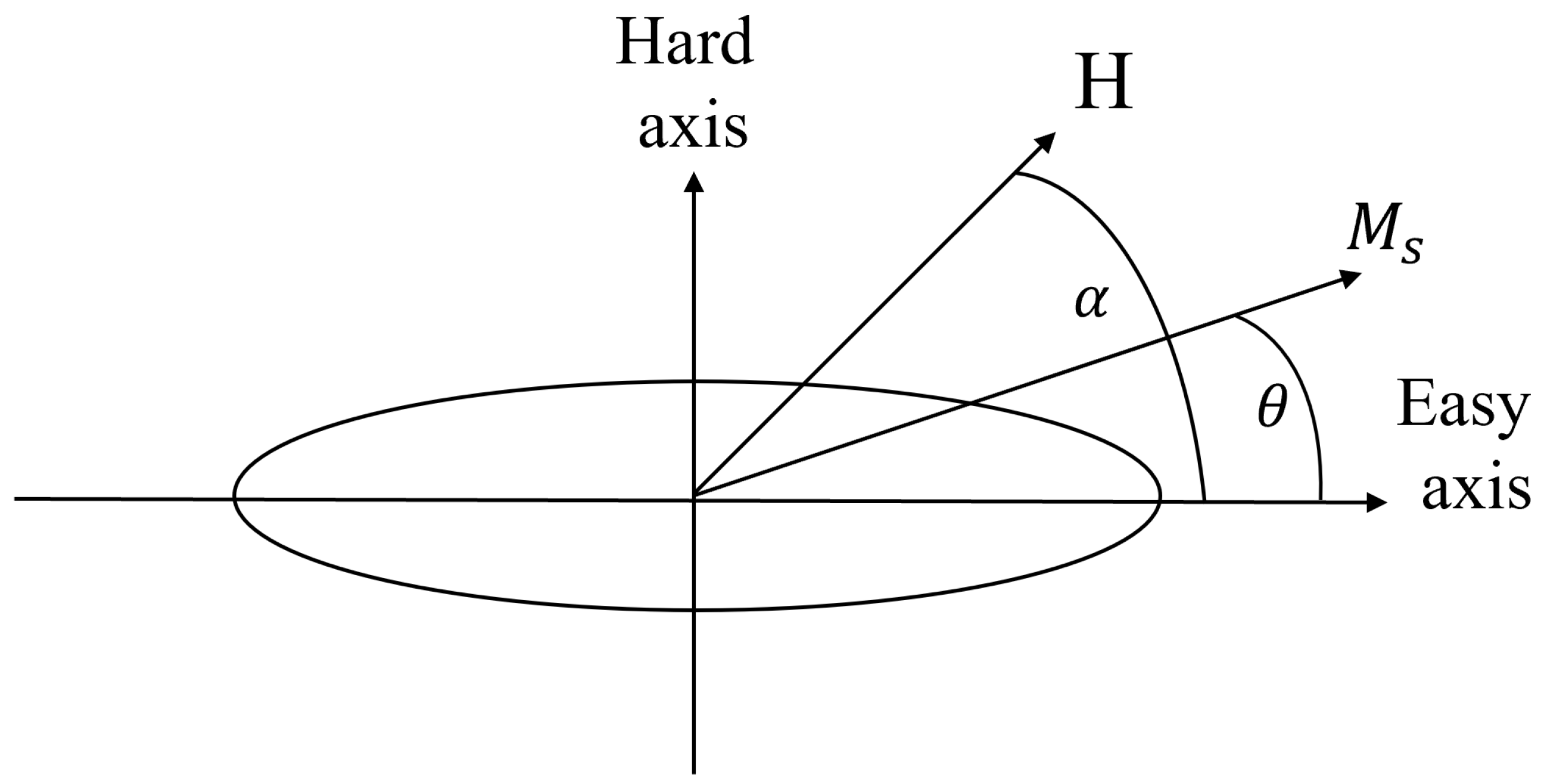

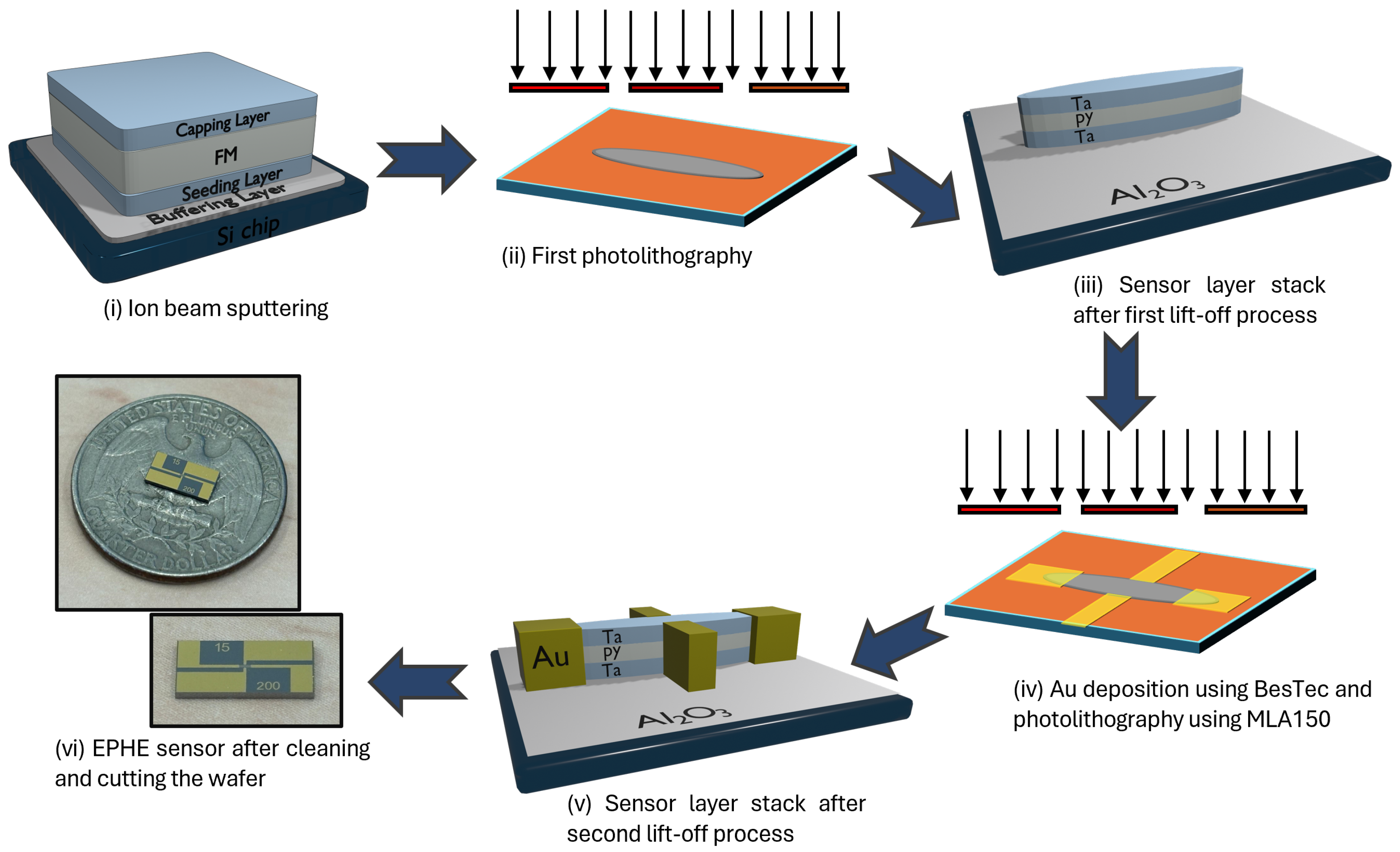
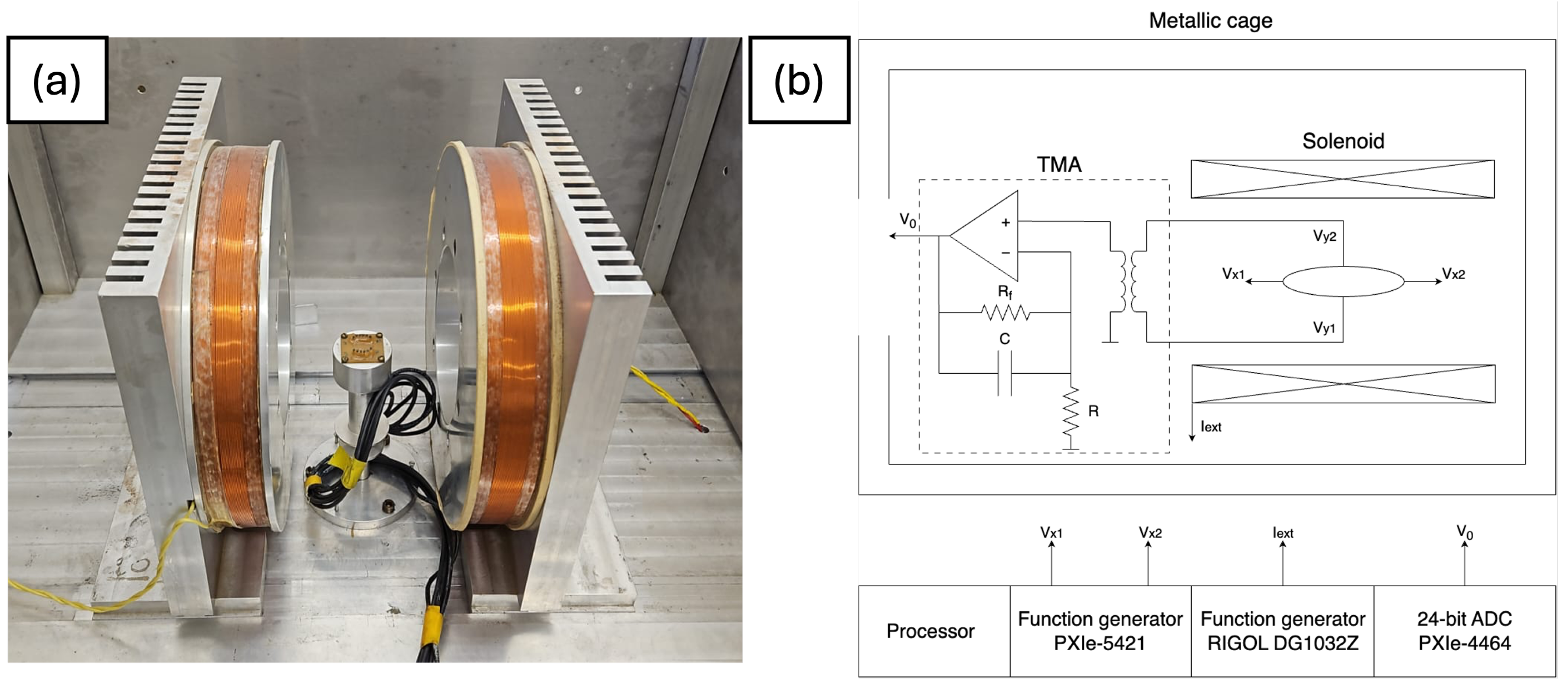

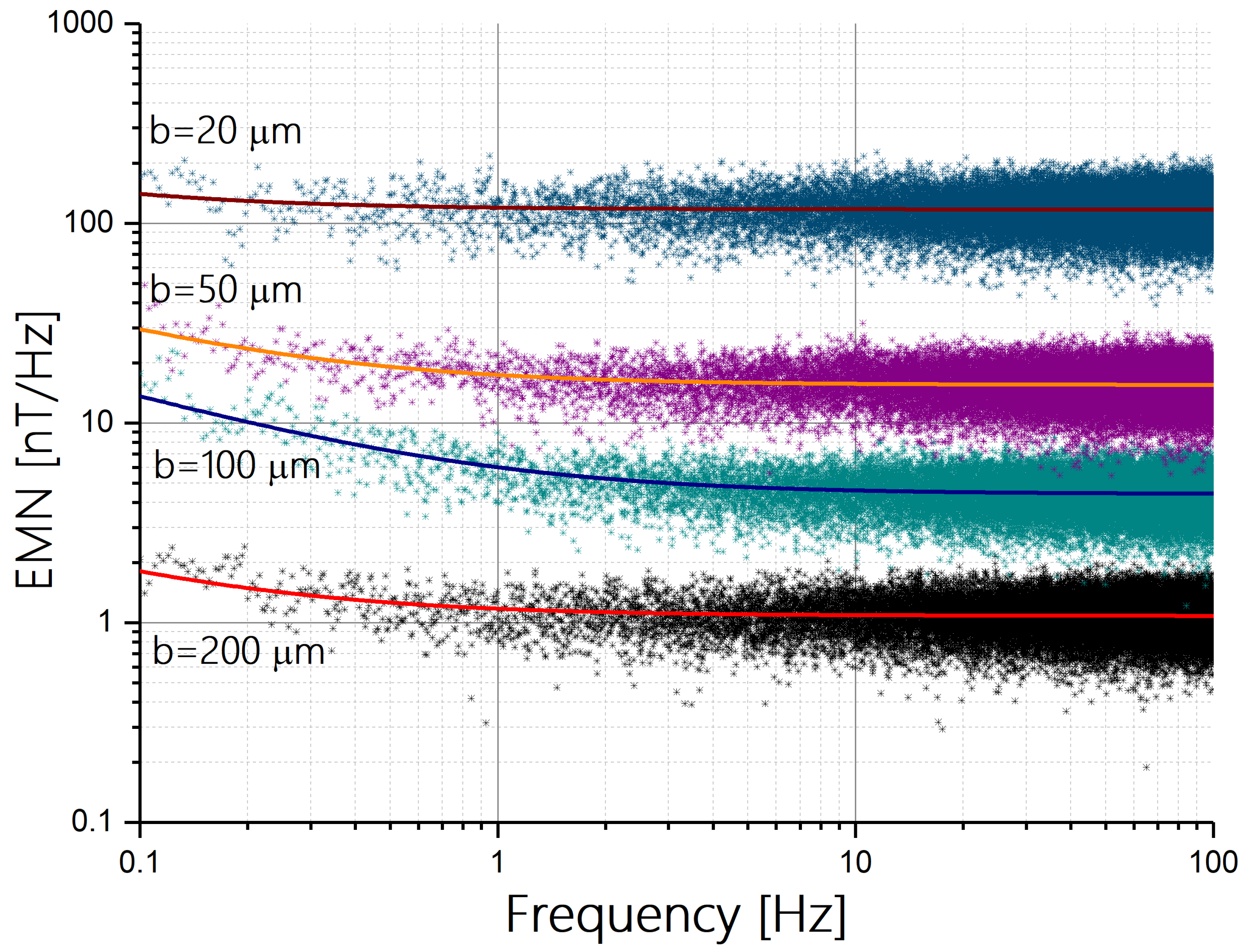
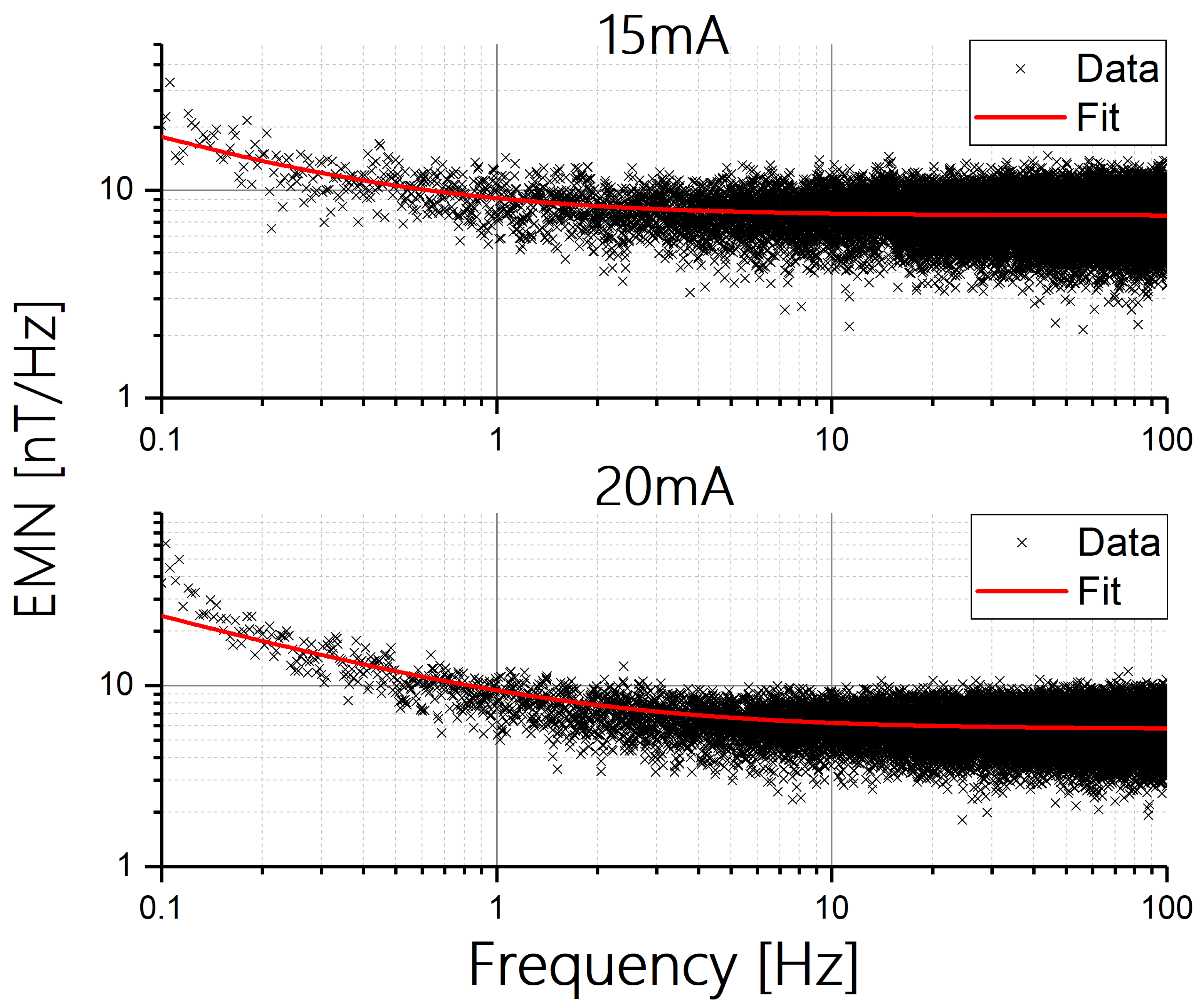
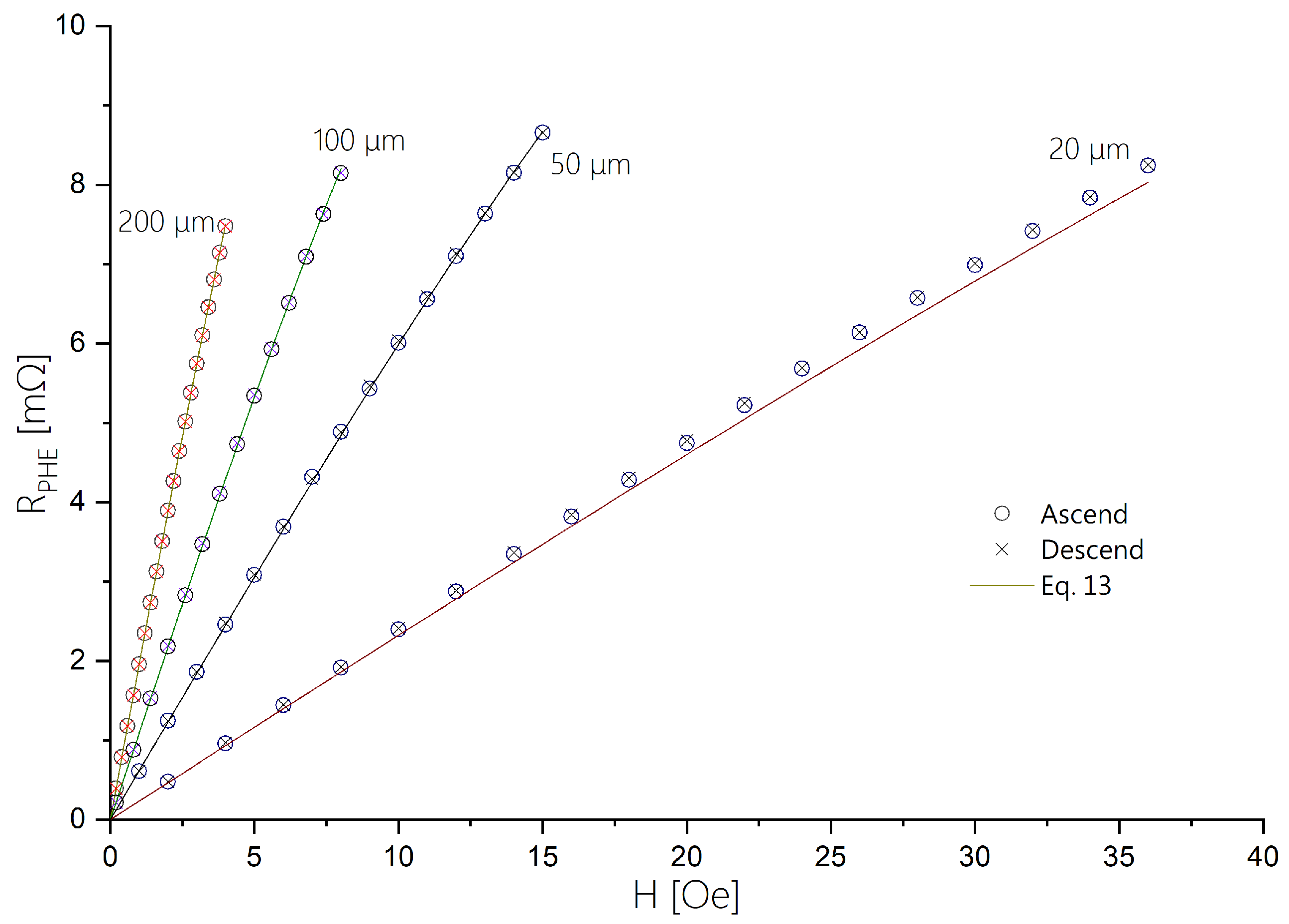
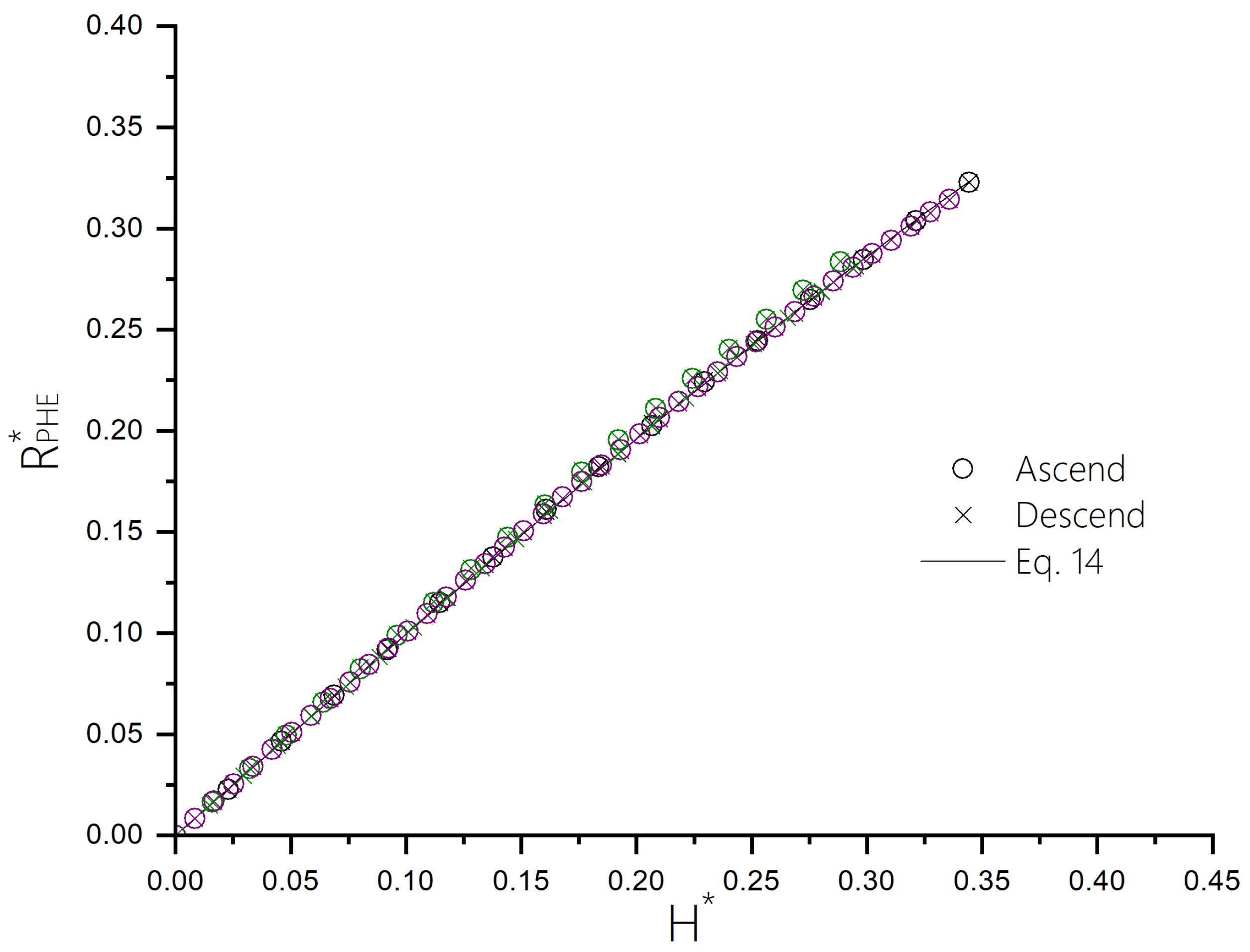
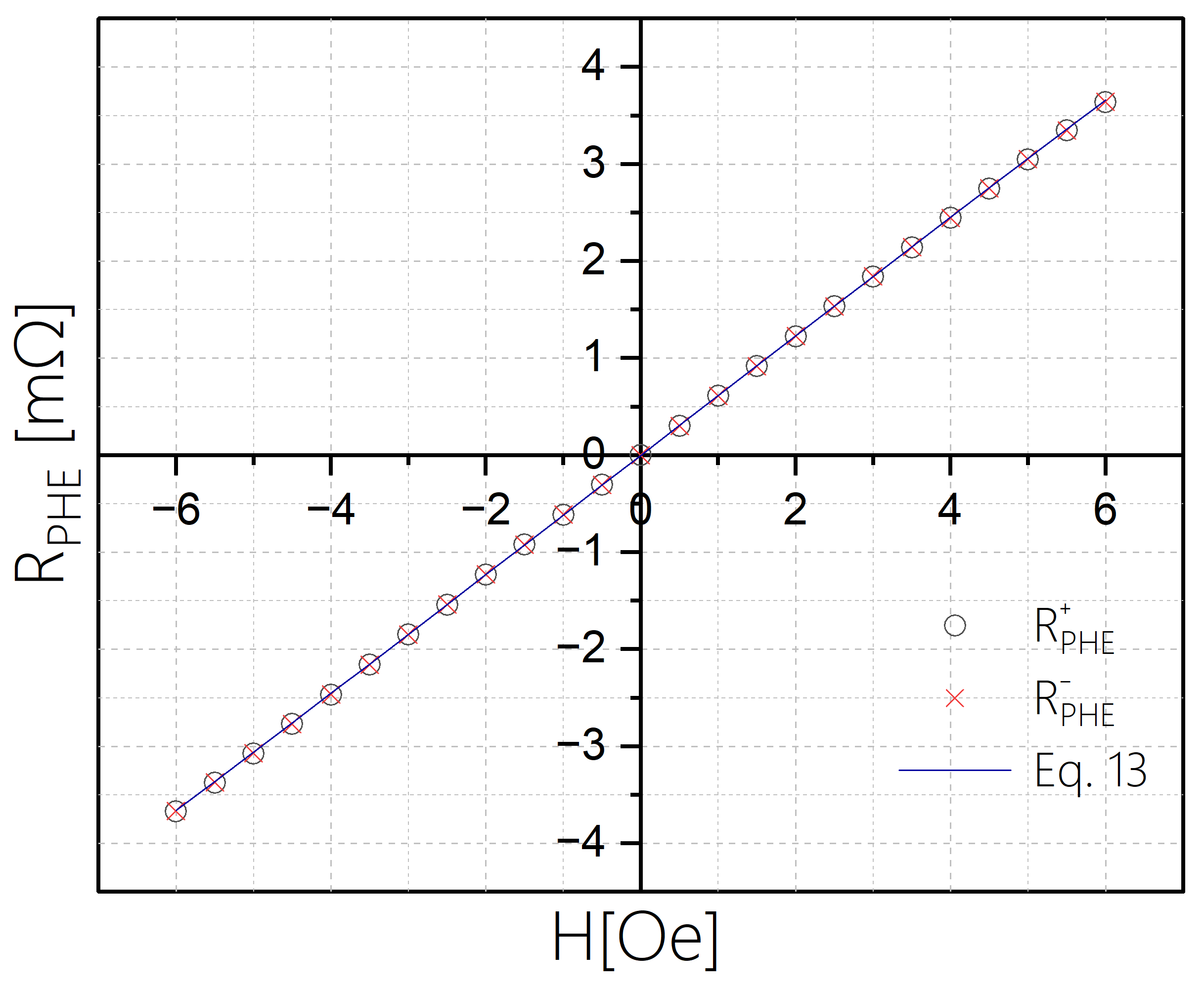

| b (μm) | I (mA) | (Oe) | () | (mΩ) | (Ω) | (Ω) |
|---|---|---|---|---|---|---|
| 20 | 3 | 124.8 | 7.2 | 29 | 8.9 | 35.6 |
| 50 | 7.5 | 43.5 | 46 | 26 | 7 | 20.7 |
| 100 | 15 | 23.8 | 151.5 | 25 | 5.6 | 14.4 |
| 200 | 30 | 13.5 | 642.1 | 26 | 5.1 | 9.8 |
Disclaimer/Publisher’s Note: The statements, opinions and data contained in all publications are solely those of the individual author(s) and contributor(s) and not of MDPI and/or the editor(s). MDPI and/or the editor(s) disclaim responsibility for any injury to people or property resulting from any ideas, methods, instructions or products referred to in the content. |
© 2024 by the authors. Licensee MDPI, Basel, Switzerland. This article is an open access article distributed under the terms and conditions of the Creative Commons Attribution (CC BY) license (https://creativecommons.org/licenses/by/4.0/).
Share and Cite
Lahav, D.; Schultz, M.; Amrusi, S.; Grosz, A.; Klein, L. Planar Hall Effect Magnetic Sensors with Extended Field Range. Sensors 2024, 24, 4384. https://doi.org/10.3390/s24134384
Lahav D, Schultz M, Amrusi S, Grosz A, Klein L. Planar Hall Effect Magnetic Sensors with Extended Field Range. Sensors. 2024; 24(13):4384. https://doi.org/10.3390/s24134384
Chicago/Turabian StyleLahav, Daniel, Moty Schultz, Shai Amrusi, Asaf Grosz, and Lior Klein. 2024. "Planar Hall Effect Magnetic Sensors with Extended Field Range" Sensors 24, no. 13: 4384. https://doi.org/10.3390/s24134384
APA StyleLahav, D., Schultz, M., Amrusi, S., Grosz, A., & Klein, L. (2024). Planar Hall Effect Magnetic Sensors with Extended Field Range. Sensors, 24(13), 4384. https://doi.org/10.3390/s24134384








